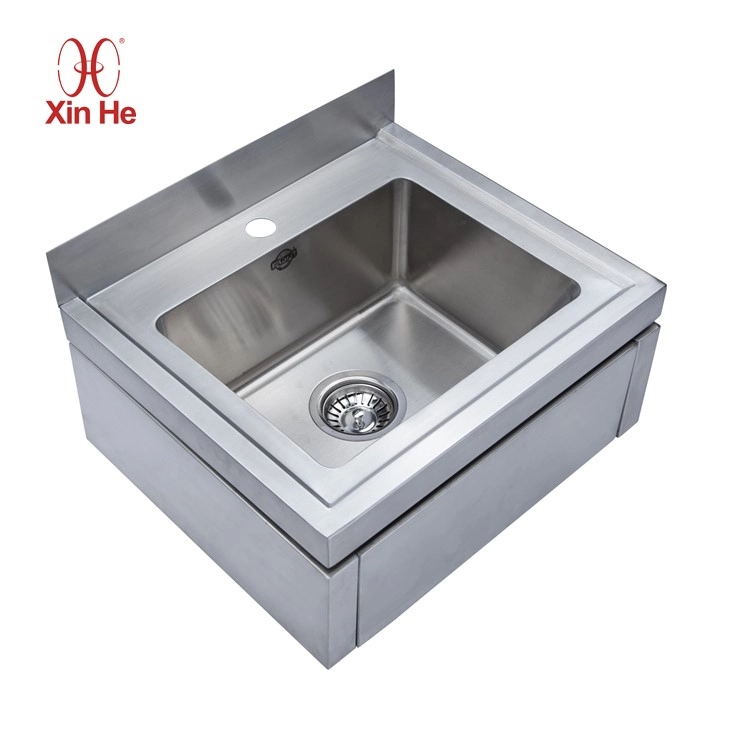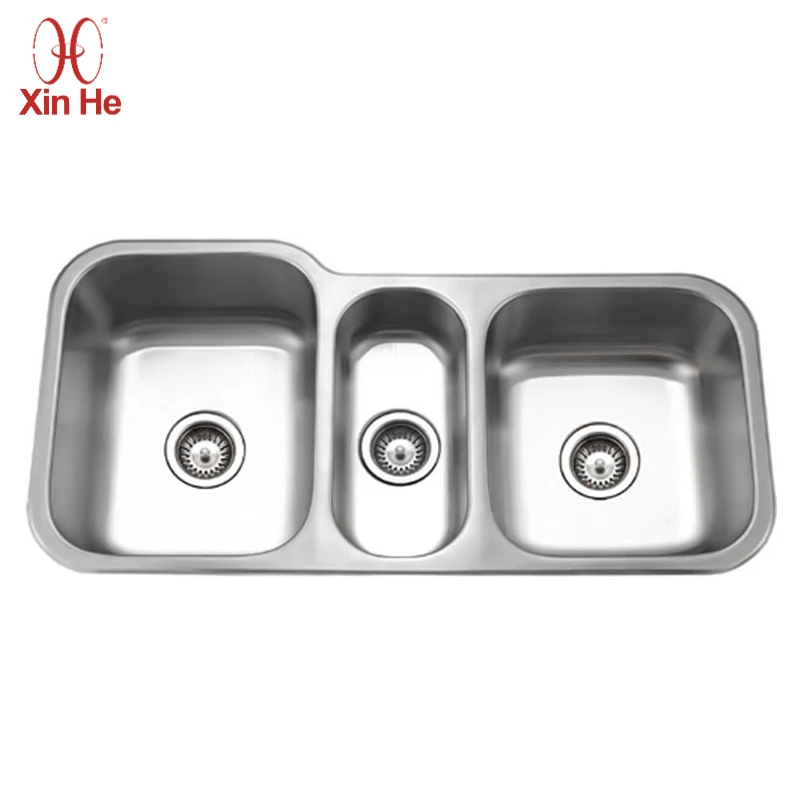Is 304 Stainless Steel Drop In Sink Truly Rust-Proof
For wholesalers, facility managers, and brand owners sourcing drop in sinks for commercial kitchens, hospitals, or public restrooms, durability is non-negotiable. A rusted sink isn’t just unsightly—it’s a hygiene hazard and a costly operational headache. So, the million-dollar question arises: Is a 304 stainless steel drop in sink truly rust-proof?
The answer is: in normal usage environments, 304 stainless steel drop-in sinks do indeed have excellent rust resistance, but they are not “absolutely rust-proof” or “guaranteed never to rust.” Understanding why it resists rust, when it might not, and how to select and maintain it is key to making a smart, long-term investment.
We’ll explain the science, debunk common myths, and provide actionable advice to help you specify the right drop in kitchen sink, drop in bathroom sink, or drop in utility sink for your clients’ needs.
Why 304 Stainless Steel is Your Best Defense Against Rust
The legendary corrosion resistance of 304 stainless steel isn’t magic—it’s chemistry and physics working in perfect harmony. This material, often called “18/8” stainless steel, contains a minimum of 18% chromium and 8% nickel .
Forming the Passive Layer
The real hero is chromium. When exposed to oxygen—whether from air or water—it spontaneously forms an ultra-thin, invisible, and incredibly stable layer of chromium oxide (Cr₂O₃) on the surface . This is known as the passive layer. This layer acts as a formidable barrier, preventing oxygen, water, and other corrosive elements from reaching the underlying iron in the steel . It’s this passive layer that fundamentally differentiates stainless steel from ordinary carbon steel, which rusts readily. The presence of at least 18% chromium is critical for forming this protective barrier .
Self-Healing Superpower
One of the most remarkable properties of this passive layer is its ability to self-repair. If the surface is scratched or abraded, the chromium in the exposed area immediately reacts with oxygen to reform the protective oxide layer . This self-healing capability is what makes 304 stainless steel so resilient in dynamic environments like a busy commercial kitchen with a drop in stainless steel kitchen sink.
Nickel’s Role
Nickel, the other key component, doesn’t directly form the passive layer but plays a vital supporting role. It enhances the alloy’s ductility, making it easier to form into complex shapes like deep drop in farmhouse sinks or multi-bowl commercial sinks without cracking . It also boosts overall corrosion resistance, particularly against acidic substances commonly found in food preparation areas .
For buyers, this means a 304 stainless steel drop in sink is engineered from the ground up to withstand the daily onslaught of water, food acids, and cleaning chemicals, making it the industry standard for good reason .

When and Why 304 Stainless Steel Might Show Rust
Despite its robust defenses, 304 stainless steel is not invincible. Under specific, often avoidable, circumstances, corrosion can occur. Recognizing these scenarios is crucial for proper specification and maintenance.
Pitting Corrosion
The most common threat to 304 stainless steel is chloride ions (Cl⁻), found in salt, bleach, and some hard water. These ions are small enough to penetrate microscopic imperfections in the passive layer . Once inside, they can initiate localized corrosion, known as pitting, which appears as small, deep holes. This is why leaving salty brine, bleach solutions, or even seawater residue on a drop in utility sink for extended periods is a bad idea. Environments with high ambient chloride levels, such as coastal areas or facilities using chlorinated cleaning agents, pose a higher risk.
“False Rust” or Iron Contamination
Often, what appears to be rust on a stainless steel sink is actually surface contamination. During installation, construction, or even cleaning, iron particles from tools, steel wool, or nearby grinding can become embedded in the sink’s surface. These particles, not being stainless, will rust when exposed to moisture. This rust then bleeds onto the stainless steel, creating unsightly stains that are often mistaken for material failure. This is easily remedied with proper cleaning and is not indicative of the sink’s inherent quality.
Damage from Abrasive Cleaning
Using harsh, abrasive scrubbers like steel wool or gritty scouring powders can scratch the surface of the sink . While the passive layer can heal minor scratches, deep or repeated abrasion can compromise its integrity, creating sites where corrosion can start. This is particularly relevant for high-traffic commercial kitchen sink areas.
The “Dissimilar Metals” Problem
If a 304 stainless steel sink comes into direct, prolonged contact with a more “active” metal (like carbon steel or aluminum) in the presence of an electrolyte (like water), a galvanic cell can form. This accelerates the corrosion of the more active metal, and the resulting rust can stain the stainless steel. Proper installation, using compatible materials and insulating gaskets, prevents this.
The “Fake 304” Problem
Perhaps the most significant risk is not the material itself, but its authenticity. Inferior grades like 201 stainless steel, which has much lower nickel content, are sometimes passed off as 304. These materials lack the necessary chromium and nickel to form a robust, self-healing passive layer and will corrode much more readily . This underscores the critical importance of sourcing from reputable, certified manufacturers.
304 vs. 316
For many buyers, the question quickly becomes, “Should I upgrade to 316?” Understanding the difference is key to cost-effective specification.
The Key Difference: Molybdenum
Grade 316 stainless steel contains all the elements of 304, plus an additional 2-3% molybdenum. This single addition significantly enhances its resistance to pitting and crevice corrosion, especially from chlorides and other halides. This makes 316 the preferred choice for marine environments, chemical processing plants, or facilities that rely heavily on bleach-based disinfectants.
Cost vs. Performance
The enhanced performance of 316 comes at a premium. It is typically 20-30% more expensive than 304 stainless steel . For the vast majority of inland commercial kitchens, restaurants, offices, and public facilities, 304 provides more than adequate protection and represents the best value . Upgrading to 316 is a wise investment only for specific, high-chloride-risk applications.
In summary, for a standard drop in kitchen sinks or drop in bathroom sinks in a typical urban or suburban setting, 304 is the smart, economical, and highly effective choice. Reserve 316 for coastal installations, industrial laundries, or healthcare settings with stringent chemical cleaning protocols.
Selecting a High-Quality 304 Drop In Sink
Specifying a sink involves more than just the grade of steel. Here’s what discerning buyers should look for to ensure maximum durability and performance.
1. Verify the Material Grade
Demand material certifications (Mill Test Reports) from your supplier to confirm the sink is made from genuine AISI 304 stainless steel. Don’t rely on marketing claims alone.
2. Assess the Gauge (Thickness)
Thicker steel is more durable and less prone to denting and noise. For heavy-duty commercial use, look for 16-gauge (1.5mm) or 18-gauge (1.2mm) steel. Thinner gauges (20-gauge or higher) are suitable for light residential or low-traffic applications but may not withstand the rigors of a busy restaurant sink.
3. Examine the Finish
A smooth, uniform finish is not just about aesthetics; it’s about hygiene and cleanability. Look for a brushed or satin finish (often called a #4 finish), which hides minor scratches better than a mirror finish and is easier to maintain. Ensure the surface is free of pits, inclusions, or rough spots that could harbor bacteria or initiate corrosion.
4. Inspect Welds and Seams (for Fabricated Sinks)
If you’re specifying a custom or multi-bowl 3 compartment sink, pay close attention to the welds. They should be smooth, continuous, and free of cracks or porosity. Poor welding can create weak points and areas where the passive layer is compromised. High-quality manufacturers use TIG welding and often perform post-weld treatments like pickling and passivation to restore corrosion resistance in the heat-affected zone.
5. Evaluate Drain and Overflow Design
Ensure the drain assembly is also made from 304 stainless steel to avoid galvanic corrosion. A well-designed overflow prevents spills and is easy to clean.
6. Partner with a Reputable Manufacturer
Choose a supplier with a proven track record, stringent quality control (like ISO 9001 certification), and experience in commercial projects. A reliable partner like Xinhe, founded in 1990, offers professional ODM & OEM services and focuses on high-quality stainless steel products for commercial, foodservice, and public facilities . Their expertise ensures you get a product built to last.

Proactive Maintenance
Daily Cleaning Protocol
- Rinse and Dry: After each use, rinse the sink thoroughly with clean water to remove food debris, soap residue, and potential chlorides. Wipe it dry with a soft cloth or microfiber towel to prevent water spots and mineral buildup . This simple step is incredibly effective.
- Use Gentle Cleaners: For daily cleaning, mild dish soap and warm water are perfectly sufficient . Avoid harsh chemicals.
Weekly/Monthly Deep Cleaning
- Baking Soda Paste: For stuck-on grime or light stains, make a paste with baking soda and water. Apply it with a soft cloth or sponge, scrub gently in the direction of the grain, then rinse thoroughly.
- Vinegar Solution: For hard water spots or mineral deposits, soak a cloth in white vinegar and lay it over the affected area for 10-15 minutes. Rinse well afterward. Vinegar’s mild acidity can actually help re-passivate the surface.
- Specialized Cleaners: For tougher jobs or to restore shine, use a cleaner specifically formulated for stainless steel. Always follow the manufacturer’s instructions.
What to Avoid
- Steel Wool and Abrasive Pads: These will scratch the surface and embed iron particles, leading to rust stains .
- Bleach and Chlorine-Based Cleaners: These are the arch-enemies of 304 stainless steel. They aggressively attack the passive layer and cause pitting. If you must use them, dilute heavily, apply for the absolute minimum time, and rinse immediately and thoroughly with copious amounts of water.
- Leaving Standing Water or Debris: Don’t let pots, pans, or food scraps sit in the sink for long periods, especially if they are salty or acidic.
Dealing with “Rust” Stains
If you encounter surface rust (usually from iron contamination), don’t panic. Use a paste of baking soda and water, or a specialized stainless steel cleaner, and rub gently with a soft cloth. Commercial products are also highly effective for this purpose . For persistent stains, a professional passivation treatment using nitric acid can restore the surface .
Conclusion
So, is a 304 stainless steel drop in sink rust-proof? In the context of its intended use, the answer is a resounding yes, for all practical purposes. Its scientifically engineered passive layer provides outstanding, self-repairing protection against the corrosion threats found in 95% of commercial and residential settings.
For a product that combines proven performance with smart value, look no further. Explore Xinhe’s full range of high-quality, customizable stainless steel sinks and discover the perfect, durable solution for your next project.



